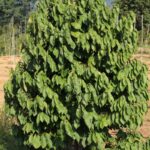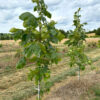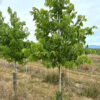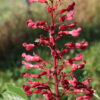Salix nigra, the black willow, is the largest member of the willow family in the Americas and one of the largest Salix species in the world. It is a broadly distributed species, with a native range encompassing the entire United States east of a line from the Chihuahuan Desert of Texas to southern Minnesota, excluding the upper Great Lakes, Maine, and peninsular Florida. The species is also notably missing from the Adirondacks and the Mohawk and upper Hudson valleys.
Like most willows, black willow appears only in wet locations in its native habitat and is tolerant of many soil profiles as long as continuous moisture is present. The species can perish easily in prolonged dry conditions but can survive inundation of the roots for over a month. In the wild, the typical form is a single or multi-stemmed tree maturing at 50 to 80 ft high with an irregularly rounded crown. The largest specimens can top out at up to 140 ft tall in protected bottomlands. Salix in general are fast-growing and weak wooded and are susceptible to damage from high winds, ice, and snow. The rapid growth rate, however, allows many damaged trees to recover quickly.
[Article continues below photos.]
The leaves of black willow are narrow and finely-toothed, typically 3-5 inches long. They are often one of the first trees to break bud in spring and retain foliage late into the autumn; the fall color is typically a bright golden-yellow. The tree is dioecious, with both male and female flowers borne on catkins but on separate individuals and are a favorite of several species of bees. Mature seeds are tiny and covered with fine silky hairs and are distributed by the wind. The bark of mature specimens is a deep black and deeply furrowed (hence the specific epithet nigra) and offers a good contrast to the foliage and the fine, bright greenish-yellow twigs of young branches.
In the landscape, Salix nigra is especially useful in stabilizing river and stream banks and in anchoring bioswales. The dense, fibrous roots effectively lock soil particles and control erosion. For the same reason, black willow should not be planted in the vicinity of water or sewer lines as the roots will aggressively seek any moisture leakage and quickly form an almost impenetrable mass. Aside from erosion control, Salix nigra is best used as an anchor element in the background in the landscape where its fine texture can contrast with coarser foreground plants and its somewhat messy habit of dropping fine leaves and twiglets can be less noticeable. The tree is extremely tolerant of pruning and can easily be kept at a smaller size or even coppiced or pollarded.
The wood of black willow is straight-grained, flexible, and very light with a pale cream-yellow color. It is easily worked and resistant to splitting, but easily rots. Traditional uses include basket-weaving, furniture, and wood pulp. It was a prime source of fine charcoal for gunpowder during the American Revolution and interestingly was the traditional wood for early artificial limbs due to its light weight. The young twigs are a favored food of many game animals including white-tailed deer (Odocoileus virginianus).
In conclusion, Salix nigra is a valuable native in the right situation. No other native tree is as useful for erosion and moisture control. Salix nigra is offered by White House Natives in 2”, 2½”, and 3” caliper. Touch base with us today to learn how this valuable native can be an important part of your next landscape project!







